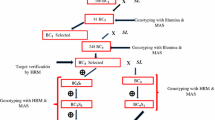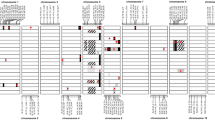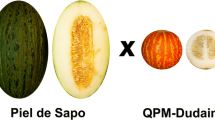Summary
The objective of this project was to introgress small overlapping chromosome segments which cover the genome of L. pennellii into Lycopersicon esculentum lines. The interspecific hybrid was backcrossed to L. esculentum, and a map of 981 cM, based on 146 molecular markers covering the entire genome, was produced. A similar backcross 1 population was selfed for six generations, under strong selection for cultivated tomato phenotypes, to produce 120 introgression lines. The introgression lines were assayed for the above-mentioned molecular markers, and 21 lines covering 936 cM of L. pennellii, with an average introgression of 86 cM, were selected to provide a resource for the mapping of new DNA clones. The rest of the lines have shorter introgressions consisting of specific regions with an average size of 38 cM. The proportion of the L. pennellii genome in the introgression lines was lower than expected (252 cM) because of strong selection against the wild-parent phenotype. The mean introgression rate for ends of linkage groups in the 120 lines was 3 times higher than for other regions of the genome. The introgression lines can assist in RFLP-based gene cloning by allowing the rapid selection of DNA markers that map to specific chromosome segments. The introgression lines also provide a base population for the mapping and breeding for quantitative traits such as salt and drought tolerance that characterize the wild species L. pennellii.
Similar content being viewed by others
References
Behare J, Laterrot H, Sarfatti M, Zamir D (1991) RFLP mapping of the Stemphylium resistance gene in tomato. Mol Plant-Microbe Int 4:489–492
Bernatzky R, Tanksley SD (1986) Methods for detection of single or low copy sequences in tomato on Southern blots. Plant Mol Biol Rep 4:37–41
Burr B, Burr FA (1991) Recombinant inbreds for molecular mapping in maize: theoretical and practical considerations. Trends Genet 7:55–60
Burr B, Burr FA, Thompson KH, Albertson MC, Stuber CW (1988) Gene mapping with recombinant inbreds in maize. Genetics 118:519–526
Feinberg AP, Vogelstein B (1983) A technique for radiolabelling DNA restriction endonuclease fragments to high specific activity. Anal Biochem 132:6–13
Gadish I, Zamir D (1987) Differential zygotic abortion in an interspecific Lycopersicon cross. Genome 29:156–159
Klein-Lankhorst RM, Rietveld P, Machiels B, Verkerk R, Weide R, Gebhardt C, Koornneef M, Zabel P (1991a) RFLP marker linked to the root knot nematode resistance gene Mi in tomato. Theor Appl Genet 81:661–667
Klein-Lankhorst RM, Vermunt A, Weide R, Liharska T, Zabel P (1991b) Isolation of molecular markers for tomato (L. esculenttum) using random amplified polymorphic DNA (RAPD). Theor Appl Genet 83:108–114
Lander ES, Green P, Abrahamson J, Barlow A, Daly MJ, Lincoln SE, Newburg L (1987) MAPMAKER: An interactive computer package for constructing primary genetic linkage maps of experimental and natural populations. Genomics 1:174–181
Levesque H, Vedel F, Mathieu C, Decurcel AGL (1990) Identification of a short rDNA spacer sequence highly specific of a tomato line containing Tm-1 gene introgressed from Lycopersicon hirsutum. Theor Appl Genet 80:602–608
Martin B, Nienhuis J, King G, Schaefer A (1989) Restriction fragment length polymorphism associated with water use efficiency in tomato. Science 243:1725–1728
Martin GB, Williams JGK, Tanksley SD (1991) Rapid identification of markers linked to a Pseudomonas resistance gene in tomato using random primers and near isogenic lines. Proc Natl Acad Sci USA 88:2336–2340
Messeguer R, Ganal M, De-Vincente MC, Young ND, Bolkan H, Tanksley SD, (1991) High resolution RFLP map around the root knot nematode resistance gene (Mi) in tomato. Theor Appl Genet 82:529–536
Miller JC, Tanksley SD (1990) RFLP analysis of phylogenetic relationship and genetic variation in the genus Lycopersicon. Theor Appl Genet 80:437–448
Nienhuis J, Helentjaris T, Slocum M, Ruggero B, Schaefer A (1987) Restriction fragment length polymorphism analysis of loci associated with insect resistance in tomato. Crop Sci 27:797–803
Paterson AH, Lander ES, Hewitt JD, Peterson S, Lincoln SE, Tanksley SD (1988) Resolution of quantitative traits into Mendelian factors by using a complete linkage map of restriction fragment lengh polymorphisms. Nature 355:721–726
Paterson AH, Deverna JW, Lanini B, Tanksley SD (1990) Fine mapping of quantitative trait loci using overlapping recombinant chromosomes, in an interspecies cross of tomato. Genetics 124:735–742
Paterson AH, Damon S, Hewitt JD, Zamir D, Rabinowitch HD, Lincoln SE, Lander ES, Tanksley SD (1991) Mendelian factors underlying quantitative traits in tomato: comparison across species, generations, and environments. Genetics 127:181–197
Rick CM (1969) Controlled introgression of chromosomes of Solanum pennellii into Lycopersicon esculentum: segregation and recombination. Genetics 62:753–768
Rick CM (1973) Potential genetic resources in tomato species: clues from observations in native habitats. In: Srb AM (ed) Genes, enzymes, and populations. Plenum, New York, pp 255–269
Rick CM, Tanksley SD (1981) Genetic variation in Solanum pennellii: comparisons with two other sympatric tomato species. Plant System Evol 139:11–45
Saranga Y, Zamir D, Marani A, Rudich J (1991) Breeding tomato for salt tolerance: I. field evaluation of Lycopersicon germ-plasm for yield and dry matter production. J Am Soc Hortic Sci 116:1067–1071
Sarfatti M, Katan J, Fluhr R, Zamir D (1989) An RFLP marker in tomato linked to the Fusarium oxysporum resistance gene I2. Theor Appl Genet 78:755–759
Sarfatti M, Abu-Abied M, Katan J, Zamir D (1991) RFLP mapping of I1, a new locus in tomato conferring resistance against Fusarium oxysporum f. sp. lycopersici race 1. Theor Appl Genet 82:22–26
Sharp PJ, Chao S, Desay S, Gale MD (1989) The isolation, characterization and application in the Triticieae of a set of wheat RFLP probes identifying each homoeologeus chromosome arm. Theor Appl Genet 78:342–348
Tanksley SD, Young ND, Paterson AH, Bonierbale MW (1989) RFLP mapping in plant breeding: new tools for an old science. Bio/Technology 7:257–264
Weber D, Helentjaris T (1989) Mapping RFLP loci in maize using B-A translocations. Genetics 121:583–590
Young ND, Miller JC, Tanksley SD (1987) Rapid chromosomal assignment of multiple genomic clones in tomato using primary trisomics. Nucleic Acids Res 15:9339–9348
Young ND, Zamir D, Ganal M, Tanksley SD (1988) Use of isogenic lines and simultaneous probing to identify DNA markers tightly linked to the Tm-2a gene in tomato. Genetics 120:579–585
Zamir D, Tal M (1987) Genetic analysis of sodium, potassium and chloride ion content in Lycopersicon. Euphytica 36:187–191
Author information
Authors and Affiliations
Additional information
Communicated by F. Salamini
Rights and permissions
About this article
Cite this article
Eshed, Y., Abu-Abied, M., Saranga, Y. et al. Lycopersicon esculentum lines containing small overlapping introgressions from L. pennellii . Theoret. Appl. Genetics 83, 1027–1034 (1992). https://doi.org/10.1007/BF00232968
Received:
Accepted:
Issue Date:
DOI: https://doi.org/10.1007/BF00232968




